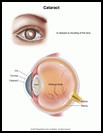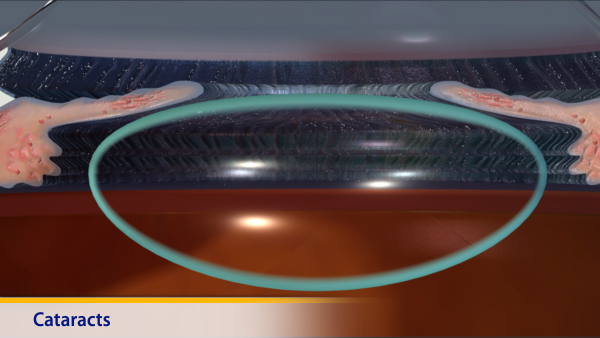
Cataract
What is a cataract?
A cataract is a cloudy area in the lens of the eye. The lens is located inside the eye behind the iris (the colored part of the eye). The lens gets cloudier over time and causes vision problems.
How does it occur?
What causes cataracts is not known, but many things may make cataracts more likely to form, such as:
- eye injury or previous eye surgery
- diabetes or other diseases
- exposure to radiation, especially X-rays
- long-term use of steroid medicine
- exposure to medicines such as gout medicines, cholesterol lowering drugs, antibiotics, and diuretics
- inflammation in the front of the eye (iritis)
- prolonged exposure to sunlight
A child may be born with cataracts or develop them at an early age. These cataracts, called congenital cataracts, may be caused by a genetic disorder (such as Down syndrome) or by a condition the mother had during pregnancy (such as German measles). They also may be inherited.
Cataracts don't spread from one eye to the other, but many people have cataracts in both eyes. The cataract can be worse in one eye compared to the other.
What are the symptoms?
The symptoms of a cataract include:
- blurred vision
- a need for frequent changes in your eyeglasses or contacts
- glare from lights, especially at night
- being sensitive to bright light
- change in color vision (yellow, orange, and red appear brighter and blue appears dull)
Cataracts do not usually cause complete blindness. However, it is possible to lose enough vision to make it hard to recognize objects.
How is it diagnosed?
The symptoms of a cataract develop slowly and are painless. The condition may go unnoticed and undiagnosed for a long time. It is often found during a routine eye exam.
An eye care provider will do a thorough exam. He or she will evaluate symptoms and determine the best course of treatment.
How is it treated?
Cataracts in young children should be removed to help prevent amblyopia (lazy eye).
If the cataract is seriously affecting vision and cannot be helped with glasses or contact lenses, a surgeon may need to remove the lens. The surgeon may first use sound waves (ultrasound) to break up the lens so the pieces can then be removed through a narrow hollow suction tube. This part of the procedure is called phacoemulsification. In some cases, the lens is removed in one piece through a larger incision (nuclear expression). After the lens is removed the surgeon will put a new plastic lens in the eye.
Lasers are not used to remove cataracts. However, they may be used to open a cloudy membrane that may develop after cataract surgery.
Cataracts in children are often associated with other problems with the eyes. This means the vision may not get better after cataracts are removed. Although a cataract cannot grow back, your child may develop a cloudy membrane months to years later. This membrane can be removed either with laser or another surgery.
What can be done to help prevent cataracts?
Wearing goggles or safety glasses during activities where your child’s eyes could be injured can reduce the risk of damaging the eyes and in turn of developing cataracts. Wearing glasses with a UV coating that protects the eyes from sunlight might prevent or delay some types of cataracts, but this is not proven.
Good blood sugar control can slow the progression of cataracts related to diabetes.


